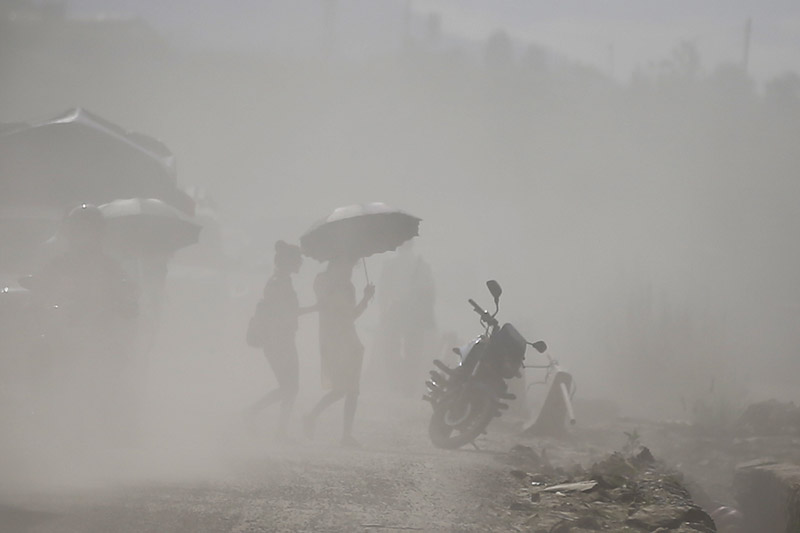Government unveils action plan to control air pollution
Kathmandu, March 6
The government has issued Kathmandu Valley Air Quality Management Action Plan-2020 to ensure fundamental right of citizens to live in clean and healthy environment.
The action plan came into force after it was approved by the Council of Ministers on February 24. ‘Kathmandu valley with clean and healthy air’ is the vision of the action plan. It has set eight objectives to realise the vision. They include reduction of outdoor pollution generated or emitted by transport and construction sectors, industrial enterprises and household waste; reduction of indoor pollution, awareness raising about the condition of air pollution, its cause, potential impact on public health, and mitigation and prevention measures; developing decision support system for air quality management; air pollution management in emergency situation; and ensuring financial resource for air pollution control by strengthening policy, legal and institutional frameworks.
Strategic features of the action plan include controlling vehicle emission, construction activities, indoor pollution, industrial emissions; management of household and agricultural waste in eco-friendly manner; ensuring environmentally sustainable transport system; awareness campaign; developing air quality management decision support system; emergency management of air pollution and developing policy and legal frameworks and resource management for its effective implementation.
As per the action plan, the government will implement Euro-IV standard, develop and enforce In-use Vehicle Emission Standard, introduce euro standard for heavy equipment and vehicles, enforce use of diesel particulate filters in diesel-powered vehicles and make provision of certification for auto workshops. These tasks will be performed within two years. The action plan envisions establishment and operation of at least five vehicle fitness testing centres and implementation of fuel economy standard.
According to the action plan, private sector will also be authorised to develop charging stations for electric vehicles. Only zero-emission vehicles like e-vehicle, rickshaw and bicycle will be allowed inside tourism and cultural sites. The government will also make legal provisions to replace old vehicles with electric vehicles within two years.
“The government will ensure no adulterated fuel is sold or distributed, besides implementing the standard of bio-fuel. Arrangement of five mobile stations will be made for surprise vehicle emission testing within one year with the participation of private sector,” it reads.
Feasibility study of mass transit system and bus rapid transit will be carried out by allocating a lane for buses along the road sections with more than six lanes. Traffic lights will be placed in major intersections of Kathmandu valley. Large vehicles will be allowed inside the valley only within prescribed time.
“Encroachment on sidewalks will be cleared by allocating a separate marketplace for existing street vendors. Piling of construction materials on footpath and road will be banned within one year,” reads the action plan. Other features of the plan include construction of flyovers, blacktopping of roads, priority to road corridor on the riverbanks, construction of parking lot for cargo vehicles in Thankot, formulation of policy relating smart parking and multi-storey parking, establishment of vehicle washing facilities in transit points of the valley, preparing detailed project report for metro system, construction of sky bridge and subway, development of cycle-friendly city lanes and pedestrian safety.
Broomer machines will be used to make the road free of dust, according to the action plan. Greenery promotion, assurance of compliance of emission standard by industrial enterprises and brick kilns, initiating action against anyone involved in open burning of refuse, safe disposal of hazardous waste, expansion of electric crematorium in Teku and Pashupati areas, promotion of use of electric stoves to reduce indoor pollution, effective regulation and monitoring of all sectors responsible for air pollution, preparation of emission inventory, emission field mapping and resource apportionment will be part of major activities to be conducted under the action plan.
If the level of Particulate Matter 2.5 exceeds 300 micrograms per cubic metre, it will be deemed emergency situation of air pollution. The government will act accordingly in emergency situation. The action plan has also designated indicators of air pollution and responsible and implementing agencies of the activities.
National Ambient Air Quality Standard of Nepal has set standard for particulate matter with aerodynamic size less than 10 micrometers called PM10 and particulate matter with aerodynamic size less than 2.5 micrometers called PM2.5. National standard for PM2.5, PM10 and total suspended particulate are 230, 120 and 40, respectively. Air pollution in the capital city is several times higher than the standard set by WHO and Government of Nepal.
Main features
- Implementation of Euro-IV standard
- Establishment and operation of five vehicle fitness testing centres
- Installing traffic lights at major intersections of Kathmandu valley
- Preparing detailed project report for metro system in valley
- Promoting use of electric stoves to reduce indoor pollution






